

Newsletter
Issue 62 1983 ~ 2008 May 2008


Table of contents
Newsdesk, and dates for your diary 2
Museum Update - 4
Merton Abbey Mills update 8
Wandle News 9
What is Logwood? 11
~~~ NEWSDESK ~~~
- Visits to the Museum have been generally good during March to May both on Wednesdays and Sundays.
- Outreach We attended the launch of the new Snuff Mill Interactive Displays in the Mill in April. These new displays will be open to the public at weekends.
 Our tent at the Environmental
Fair, with a first outing for the
new banner
Our tent at the Environmental
Fair, with a first outing for the
new bannerUnfortunately we were not able to have a stand at the Morden Hall Park Fair this year owing to their increased charges. However we were happy to participate in the National Trust's first Environmental Awareness Day called The Big Green Day Out on May 18th. Along with other organisations like the Wimbledon Beekeepers and Groundwork Merton we had a free stall and were able to publicise our Museum and sell a few books and pamphlets to an interested group of visitors. Fortunately the weather was kind to us and our thanks go to the willing team of volunteers who helped set up and man the stall.
- Volunteers We have a great team of people helping us at the Museum at present. Michael Taylor, Cy Burman, Alison Cousins and Peter Cousins have all recently joined us and are contributing well within the Museum framework.
The next Volunteers' Lunch Meeting will be on Wednesday July 9th at 12 noon. We hope to see as many of you there as possible.
Events
- Wandle Valley Festival 7th / 8th June
Assorted Wandle-related activities going on along the Wandle - Mary Hart and team will be doing block- printing demonstrations at the Chapter House. See Nicholas’ article below for details of this and the launch of Dave Saxby’s new booklet on the Mills of the Wandle.
- Opening of new Silver Jubilee Exhibition Looking Back, Looking Forward on 14th June, celebrating 25 years of our Museum.
We hope to see as many members as possible at the Opening Ceremony to be performed by the new Mayor of Merton at 11.00am on Saturday 14th June. As usual refreshments will be provided by Mary Hart and we hope we will have a fine day. The Museum will be open that day from 1.30pm to 4.00pm so if you are unable to come to the opening, we hope to see you in the afternoon.
- The Wimbledon Village Fair is on Saturday June 21st from 1 1.00am onwards. We shall once again be having a stall here at this popular venue and do hope some of you may be able to help us on that day.
Sheila Harris 2 1/5/2008
Visit to Kew Bridge Steam Museum
Following a suggestion at our last Volunteer’s lunch, a visit has been arranged for members and friends for Saturday July 26th to visit this Museum at the request of members. On this day the Cornish Beam Engines will be operating and this is an event not to be missed.
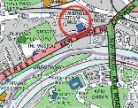
We shall meet there at 11 00am. Cost per person £8.50 adults and £7.50 concessions. Café available for refreshments. Kew Bridge Steam Museum is in Green Dragon Lane, a few minutes' walk from Kew Bridge Station and has car parking for 45 cars.
After lunch there will be a chance to visit the Musical Museum five minutes away in Brentford High Street. Cost per person £7.00 and concessions £5.50. Café available. This Museum contains one of the world's largest collection of self-playing musical instruments from music boxes to the 'Mighty Wurlitzer'.
Please ring the Museum to book your places by Friday 11th July at the latest. This should be a great day out and we hope it will be well supported.
For full details of the museum go to www.kbsm.org
Museum News
- Accreditation
As signposted in our last newsletter, we have now received provisional accreditation. Accrediation means we are on the list of Museums approved by the regulators as complying with certain standards, and is the system which replaces ‘Registration' which we achieved 5 years ago.
There are thee hurdles we must still cross, but we have until, April 2009 to do so.
Two are wholly within our own control ("minimising risk of damage to and deterioration of the Collection" and "Expert Assessment of the security arrangements to be obtained, implementation of recommendations and Review at least every 5 years". The accreditation team of Meg, Jackie and Sheila have these well in hand.
The third is most difficult. It is headed "Secure Occupancy Arrangements, including Stores." What the MLA are looking for is for us to have a legal lease of our premises. As soon as we sign at Ravensbury, that becomes satisfied. In the meantime, we are the beneficiary of a most generous and flexible arrangement at Vestry Hall Annexe, granted to us by LB Merton.
Originally this was a very straightforward matter. Merton allowed us the use of the Annex free of charge, and, indeed, e have a letter signed by Robert Hobbs in 1999 which confirms that we have continued occupancy on that basis until the move to Ravensbury can take place.
However the position has become complicated. Internal financial controls within the council have created a situation where we are being notionally charged £8,000 pa rent (£8 per square foot) and a service charge of c ££13,790 ( a somewhat arbitrary calculation based on our 1,000 sq ft of space as a fraction of all the let space in Vestry Hall). We now show this throughput in our annual accounts, as the more observant of you will have noticed.
Largely this passes us by, and we continue to be grateful for this support.
However the requirement for us to have a more formal arrangement to satisfy MLA (if we are not in Ravensbury) co-incides with the issue of new 10 year leases to the various community bodies which occupy Vestry Hall. Those leases commit the lessee to pay the rent chargeable, and to contribute to the service charge (which includes the capital costs of building repair and maintenance). Even though there is a 6 month let out clause, that would not release the lessee from the service charges and rents already accrued. It is legally impossible for the directors of the Museum to agree to the signing of such a lease without LB Merton signing a legally enforceable parallel undertaking to pay all such costs - and we don't see why they should have to do so.
What Merton can do for us (and they are trying - see below) is to resolve the impasse at Ravensbury so that we can sign the lease there.
Hopefully, by April next year this will be sufficiently far advanced that the current informal arrangement at Vestry Hall will be accepted by MLA as entirely sufficient for final Accreditation.
- Mills of the Wandle.
On a much more positive note, the Museum will be launching, jointly with Wandle Valley Festival, the new publication Mills of the Wandle, written by Dave Saxby and which we have co-sponsored and part funded.. This is a wonderful development - it is the single most sought after book title that hasn't previously existed. Target price is £2.95, and it will be on sale in the Museum shop to coincide with the opening on 14 June.
The launch itself will take place at the Wandle Valley Festival, around lunch time on the 8th June at Merton Abbey Mills - yet another reason to come and join the activities that weekend.
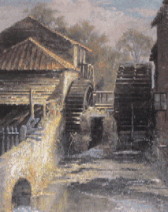
The book covers the timeline which provides the historical context for the Wandle as an industrial river, summarises the various industries it supported, and gives a list of those mills which have left sufficient physical evidence to be spotted by walkers on the Wandle Trail.
One of the reasons a publication like this can be contained in 24 pages of A5 (our preferred size to encourage readers to carry it with them on their walks) is because it can refer more detailed historical detail on the mills to McGow's Mills of the Wandle, which anyone going to our website can read.
One day someone will have the time and skills necessary to transfer McGow into publishable form, but until then its existence on the website means that the invaluable research it contains remains freely available to all.
Peter McGow and Dave Saxby have between them filled a huge void in published material. The third arm of this, the research papers of the late Peter Harris on the mills (written from a more narrative perspective, but in much more detail then Dave Saxby had room to provide) will complete the picture when his work and his own illustrations of the mills' history can be readied for publication.
Last, but by no means least, we must also thank Vicki Carrol of Wandle Valley Festival, without whose drive and energy, and fundraising skills, the new publication would not have been possible.
- Ravensbury
The situation at Ravensbury remains overcast, but there is a small speck of blue sky to provide hope. Cllr Maurice Groves has been tireless in keeping this unsatisfactory position in front of the various officers at Merton. This has reached the extent that there is now a six weekly meeting of all relevant officers, who are obliged to bring progress reports to each meeting. This should have the long awaited effect of our file being close to the top of their in trays, and not stuck at the bottom.
.jpg)
The two parallel problems remain the same in the interim - Merton has still not agreed the document that HLF needs to enable us to move forward with our lottery application, and builders have still not bee instructed to complete the s106 works. I had a conversation with Simon Williams, Director of Housing and Environment at LB Merton, and the person responsible for overseeing this effort, that progress is now being made and that we will be kept informed of progress. We hope we may now start holding our collective breath.
- Copper Mill/Electricity Alliance
The old copper mill site (just behind Dees in Plough Lane) will be peripherally affected by the proposed redevelopment of the electricity substation there - although the remaining building is off that site, much of the original mill complex remains under it). Worryingly all planning consideration are geared to the north of the site, where the Electricity Alliance will take over the Cappagh site and which falls within Wandsworth, yet the consequent changes to the current site fall with Merton. It is our hope that this development will not fall between the two stools, and neither heritage department ensures that any excavation work allows for proper recording of the older industrial archaeology below.
Ed., May 2008
Merton Abbey Mills News
 The new windvane
The new windvane
Merton Abbey Mills remains a fruitful source for current news. The energy of Terry Bucknall ensures that nothing stands still. As always anything new in a historic site causes concern, but without continual regeneration such sites lose their credibility, so there is a price we must expect to pay.
The most obvious new development is that brave new addition to our skyline - a 20m tall iconic windvane. The turbine driven by the vane will be used to supply 100% green electricity to The Colour House Children's Theatre, making it the world's first theatre to be powered exclusively by wind energy. The installation of the wind turbine was organised by Office Estates Limited (London & Argyll Group), the theatre's landlord, and forms part of the London Borough of Merton's regeneration plans.
The 25 April saw a launch party, headlined by inventor Trevor Bayliss, and with the opening performed by Mayor John Dehaney, with words from Peter Wallder of The Colour House Theatre, the Mayor, Ramsay Dunning from green energy
 Proposed extension to the
1929 building
Proposed extension to the
1929 buildingand Julia Groves.
Co-incidentally, the same day saw a presentation of Terry's building plans for the MAM site. The most immediately visible of these is the conversion of the Long Shop into show units, with the unfortunate loss of some of the trademark window arches. Much of the original architecture is to be retained, and the market stalls now relocated to the adjoining marquee.
 The new Wandle Centre building
The new Wandle Centre buildingOn show were the plans for the new 2nd floor of the 1929 building, and the new Wandle Centre - see illustrations. These works will change the appearance of the overall site, but are geared to making the site a profitable commercial enterprise (necessary if its future is to be protected). We remain hopeful that the final iteration of these plans will complement the site, and not, by unsympathetic implementation, destroy the atmosphere we all now enjoy.
If the new site then becomes a wi-fi hotspot we will know MAM has really joined the industrial 21st Century!
Wandle News
The river Wandle has made a most remarkable comeback from last October's disastrous pollution escape from Beddington with stickleback now being seen again in the upper reaches.
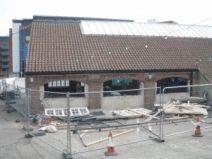 The Long Shop before removal of the
arches
The Long Shop before removal of the
arches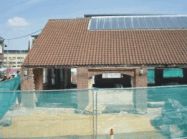 ... and after
... and afterOne of the byproducts was the donation by Thames Water of £500,000 (£100,000 p.a. for 5 years) to help with the regeneration of the River and its wildlife. Wandle Trust will have personal control over half this (probably to fund a paid member of staff) with the rest available at £50k pa for awards to other projects to help the regeneration of the Wandle.
A packed meeting at Morden Hall, chaired by National Trust, saw a presentation by Wandle Trust, to whom implementation of the awards has been handed, and Thames Water.
For a detailed transcript of questions asked, and the answers given, you can see these on the Wandle Trust website at www.wandletrust.org/discuss.htm.
Theo Pike of the Wandle Trust tells me "Yes, the guidelines for the £250k "Habitat Fund" of the Thames Water settlement have now been published: you'll find them on the Wandle Trust's forum, deeplinked here: http://82.109.178.234/forums/p/16/19.aspx#19
Exact processes for submitting applications are still being worked out, but if you have any outline ideas which you'd like to summarise and send to me in the meantime, I'd be delighted to pass those on to the other members of the Steering Group for consultation."
If you look at this page, it seems decisions have been taken behind closed doors to limit the application of the money, and restrict it to larger groups who have the resources to make lottery style bids with all the restrictions and paperwork that entails. The chance of any small group with a good idea, or small project that requires minimal cash, balanced by volunteer effort, seeing any of this money is remote. The very few large groups who can play this game all have special agenda, and a chance has been lost. The Wandle Trail is not to be a target for any of this money, but if any Reader has an idea for how it can best be used, please make contact with the Trust.
One of the reasons the Wandle Trail is not to benefit from this money is that a combined TFL and borough funding bid to deal with its upgrade is close to fruition. By next year we should be seeing real progress on this.
ED., May 2008
What is Logwood?
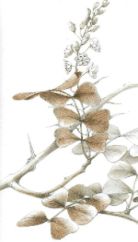 Blossom of
Haematoxylum
campechianum
(logwood)
Blossom of
Haematoxylum
campechianum
(logwood)Anyone reading about the industrial history of the Wandle will come across references to logwood mills. Many, as I used to, will note the name, assume it meant the mill had a sawmill use, then move on.
In this I was wrong, as later became apparent. Logwood took over from woad as one of the principal natural dyes used by the cloth industries of the Wandle, as the source of Hematoxylin.
Hematoxylin is one of the most common stains in histology. It is a stain derived from a natural source. This natural source played a major role in the development of the West Indies and Central America; in the incurrence of multiple wars between Spain and England; and in the creation of the country of Belize? (Did we forget to mention pirates?)
It is derived from the Haematoxylum campechianum tree, a medium-sized, evergreen, thorny tree with small, five-petal, yellow malodorous flowers, which reach 15 metres in height, and is naturally distributed throughout Guatemala, Belize, and the Yucatan Peninsula of Mexico in areas of periodic flooding with poor drainage. It has been successfully introduced throughout the Caribbean, Central America, and northern South America. The bark and sapwood are extremely hard, and protect the very hard, very heavy, deeply red-colored heartwood from which Haematoxylum derives its name ( Greek haemato for blood and xylo for wood). Crude hematoxylin is extracted from chips of the heartwood using hot water or steam, and has been used as an astringent to treat diarrhea and dysentery, as a pH indicator, as well as a dye for clothing or tissue. The seeds are also used locally as a flavouring for food.
The extract was first used by the Mayans and Aztecs as an ink, a fabric dye, and a treatment for diarrhea. When Hernando Cortez encountered the Nahuatl Aztecs in 1519, they were dressed in the rich violet and black colors derived from H campechianum extract.
- The fight over logwood
The conquering Spaniards did not initially understand the value of logwood, and the Mayan dyeing methods were lost with the destruction of their libraries. The Spaniards originally used the cut trees as ballast for their long journeys across the Atlantic. t was only after European textile artisans recognized the value of the extract as a dye that the Spaniards began to harvest the trees for sale. By the late 1500s, Spain was harvesting and exporting large amounts from the Yucatan to compete with indigo in the textile market. The extract was introduced to England in the 1570s, where it competed with the locally grown woad as a blue, purple, and black fabric dye- colors usually available only to royalty. There, it was given the name "logwood" (also "blockwood") because it was transported as three-foot logs or blocks. Though logwood began to increase in popularity in England, Spain's monopoly of the logwood source created a supply issue, as logwood was contraband cargo for non-Spanish ships.
Under Henry VIII's reign, English privateers attempted to solve supply issues by "relieving" Spanish ships of their logwood cargos. This practice of piracy continued into the late 1500s and the reign of Queen Elizabeth I, who tacitly encouraged privateering as an expression of patriotism. Privateers included George Clifford; the third Earl of Cumberland (10); Sir Walter Raleigh and Captain James, who found that logwood sold for 100 to 160 pounds sterling per ton. A ship could carry 50 tons of logwood, which would net more in one trip than a year's worth of any other cargo. The struggle over logwood fuelled rising tensions between England and Spain, culminating in the sinking of the Spanish Armada in 1588. England's new supremacy at sea opened more opportunities for acquiring logwood for the textile industry.
- Logwood and the textile industry
During the late 1500s, though logwood extract was coveted by the growing English textile industry as relief from existing drab colors, widespread use faced challenges besides limited supply. Growers of woad, a plant indigenous to Britain that contains low concentrations of indigo, furiously opposed use of logwood extract. Though the smell of fermenting woad was often decried as foul, and the use of woad as a dye required multiple repetitions to achieve the desired effect, the woad growers mounted organized opposition to logwood.
Aiding the woad growers in their opposition to logwood was the lack of colorfastness in logwood dyed fabrics. Because the Mayan and Aztec dyeing methods had not been preserved, European dyers did not initially understand that dyeing with logwood extract required treatment with a metal salt, called a mordant. Therefore, the fabrics dyed with logwood extract faded quickly after purchase. These issues, combined with Queen Elizabeth's desire to limit Spain's profit from legal logwood sales, helped pass an Act of Parliament in 1581, banning logwood use in England. Shipments of this "deceitful dyeing wood" were subject to seizure and burning for the next 70 years, despite resentment from English dyers. In 1620 in Holland, however, Cornelius Drebbel developed
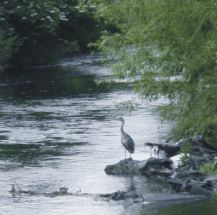 A totally gratuitous image - a heron on
guard at the confluence of the Wandle
and Graveney, May 2008 - N Hart
A totally gratuitous image - a heron on
guard at the confluence of the Wandle
and Graveney, May 2008 - N Harta process of metal mordanting to make another natural dye - cochineal, a red stain derived from insects - colorfast. This process spread throughout Europe and was effectively applied by English dyers to logwood. With colorfast logwood dyes in use and in demand, the English Parliament lifted its ban on logwood in 1661; the logwood trade then became increasingly profitable. British buccaneers soon found that harvesting logwood was more profitable than raiding Spanish cargo ships, which were now guarded by the remnants of the Spanish Navy. British pirates and settlers quickly established logwood camps in the British Honduras and along Campeche Bay in areas not already settled by the Spanish. Misinterpretation of the 1670 Treaty of Madrid, which attempted to define British and Spanish interests in the West Indies, created increasing tension between the Spanish and the logwood cutters, who both claimed the logwood forests as their own. British logwood camps were constantly under attack by the Spanish, in raids meant to discourage settlement.
- The Logwood cutters
Logwood camps were built among the natural habitat of logwood trees- swamplands. The logwood-cutters- "Baymen," as many lived along the Bay of Campeche- lived in huts built on low-level, wet, shifting ground swarming with clouds of mosquitoes. Often the highest ground available was a pile of logwood chips formed from preparing the trees for shipment. Food was scarce, leaving the Baymen to hunt manatees in surrounding mangroves. Cutters often worked all day in several feet of water, chipping slowly at very hard wood to remove the bark and sapwood. The heavy wood had to be floated through swamps on rafts made from more buoyant wood, then disassembled at the desired destination.
Despite the unpleasant conditions, logwood cutting was a profitable venture, and the settlements grew. The British Honduras experienced a great deal of this growth, with the first settlement created by Captain Peter Wallis at the mouth of a river. His name was given to the town and the river, and was progressively corrupted to Vallis and, finally, to Belize. As more settlers were attracted, Belize grew and established more permanence. Ironically, piles of logwood chips, the highest elevations, quickly became the most desirable locations for building.
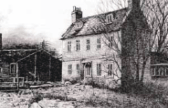 Logwood mill, Mitcham (25)
Logwood mill, Mitcham (25)After 1715, logwood was successfully introduced and naturalized in Jamaica and Haiti; by 1800, the supply of logwood had outgrown the demand for the dye. By the mid-1800s, the development of coal-derived aniline dyes had dramatically reduced the demand for logwood. These changes were reflected in Belize, where mahogany had begun to replace logwood by the 1770s as the commodity of choice. The importance of logwood to its development, however - -and to the establishment of the only permanent British presence in Central America- is reflected by a white and a black logwood cutter on both the national flag and on the currency of Belize.
To be used successfully as a tissue or fabric dye, the weakly acidic hematein derived from logwood must be combined with a mordant, a polyvalent metal ion. The mordant combines with hematein by a covalent and a coordinate bond- called chelation- to form a basic compound that binds strongly to acidic tissue, such as nucleic acids. Through use of various mordants, almost any color in the rainbow can be achieved with hematein: for example, gold produces orange, antimony produces crimson, and magnesium can produce either yellow or purple. The most commonly used mordants used in histotechnology are aluminum and ferric iron.
Nicholas Hart, May 2008
The Vestry Hall Annexe, London Road, Mitcham, Surrey CR4 3UD
Tel: 020-8648-0127
~~~~~~~~~~
OPEN: Every Wednesday 1 ~ 4 pm;
First Sunday of each month 2 ~ 5 pm.
~~~~~~~~~~
The Museum is also open to schools and groups by appointment.
~~~~~~~~~~
Admission: Adults 50p, Children & Senior Citizens 20p
The Wandle Industrial Museum would like to point out that the views of contributors to this newsletter are not necessarily the views of the Museum. We would be happy to give the right to reply to anyone who finds the content contentious.



